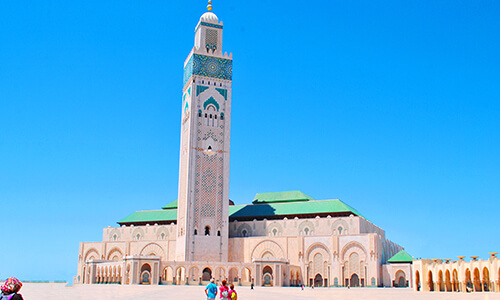About Morocco
About Morocco

Best Morocco tours
Morocco offers a spectacular blending of European, African, Jewish, Berber, Islamic and Arab influences. Fascinating landscapes include splendid snow-capped mountains, unspoiled beaches, vast stretches of Oasis, Berber fortress, green river valleys and labyrinth of ancient cities. The markets in the cities are a wealth of beautifully designed handicrafts. Traditional Kasbahs and riads are restored for offering them as hidden guesthouses which can be basic and also luxurious. Taste the signature Moroccan cuisines like chickpeas and vegetables, lentils, home-cooked tagines with vegetables or chickens flavoring rich spices like cumin, garlic coriander and saffron and full-flavored harira soup of lamb. Flat bread is the staple food of the Moroccan diet. Best Morocco tour packages always provide all these enjoying items.
Sahara's Weather
Morocco’s climate is very diverse, varying with the season and region. In general the country has a tropical climate, with temperatures reaching as high as 35°C (95°F) and as low as 5°C (41°F) in the Sahara. The coast has a warm, Mediterranean climate tempered on the eastern coast by southwest trade winds whilst inland areas have a hotter, drier, continental climate. In the south of the country, the weather is very hot and dry throughout most of the year, though temperatures can drop dramatically at night, especially in the months of December and January.
Rain falls from November to March in coastal areas, and the country is mostly dry with high temperatures in summer and a cooler climate in the mountains. Marrakech and Agadir enjoy an average temperature of 21°C (70ºF) during the winter.
Owing to the relatively high winter temperatures, and summers that are dry rather than unbearably humid, Morocco is an all-year round destination. If you really want to avoid the heat, the best time to visit is during the shoulder seasons of April to May, and September to November.


History
Morocco boasts a culturally diverse heritage with roots tracing back to prehistoric eras. Immigrants from the east seamlessly integrated with existing tribes, giving rise to the forebears of the Berber tribes. Nestled in the Rif Mountains since the Neolithic age, the Berbers played a pivotal role in history. The northern part of Morocco's western region fell under the control of the Roman Empire, and a strategic alliance between the Romans and the Berber tribes emerged after triumphing over Carthage in 146 BC.
Fast forward to the 7th century, the Arab invasion left an indelible mark on Morocco, introducing Islam as the predominant religion. The historical narrative unfolds with various ruling dynasties, such as the Idrissids, the Almoravids, the Almohads, and the Merinids, shaping Morocco's trajectory over the centuries. Notably, these dynasties grappled with the challenge of maintaining the steadfast support of Berber leaders.
Morocco and Europe
Morocco's rich and diverse history unfolds as a tapestry woven with ancient civilizations and colonial impacts. Initially inhabited by Berber tribes,
the region witnessed the presence of the Roman Empire and the advent of Islam brought by Arab invaders. Throughout the centuries, several dynasties,
including the Idrissids, Almoravids, Almohads, and Merinids, ascended to power, yet none could secure enduring support from the Berber leaders.
In the 15th century, Morocco faced challenges from Portugal and Spain, successfully repelling their invasion attempts. However, the tide turned with the onset of
European imperialism in the mid-19th century, leading to a scramble for control. By 1911, France assumed the role of protectorate ruler,
with Spain acquiring specific territories. Although French rule concluded in 1953, its cultural imprints persist. In the contemporary era,
King Mohammed VI commands widespread respect, actively addressing crucial issues to foster stability and economic growth in Morocco.




